MHD Pulsatile Flow of Blood-Based Silver and Gold Nanoparticles between Two Concentric Cylinders
Abstract
1. Introduction
2. Mathematical Formulation
2.1. Physical Problem
2.2. Governing Equations
2.3. Boundary Conditions
3. Solution of the Problem
Pressure Calculation
4. Code Validation
5. Results and Discussion
6. Conclusions and Prime Findings
- ▪
- Because of the reduction in wave amplitude at high frequencies, the maximum velocity and temperature tend to stay constant.
- ▪
- It is likewise seen that the expansion of Ag-Au hugely expands the temperature of the base liquid.
- ▪
- HNF are more potent coolants than standard base liquids since they can dispose of more warmth than typical base liquids. Because the Womersley number is the ratio of throb to thick powers, an increase in the Womersley number gradually reduces the gooey powers.
- ▪
- It is likewise found that decreasing viscous powers improve the movement of the liquid particles to become quicker, and, therefore, result in a incremental change in the speed profile.
- ▪
- Taking into account viable warm conductivity, it is additionally resolved that blood-based Ag-Au has a higher heat transfer rate when contrasted with the pure fluid.
- ▪
- We may investigate physical properties such as the skin friction coefficient, as well as assess the problem using radiation and magnetohydrodynamic effects to identify the causes of stenosis, which may aid in the treatment of arterial stenosis.
Author Contributions
Funding
Data Availability Statement
Acknowledgments
Conflicts of Interest
Nomenclature
| density of HNF | |
| viscosity of HNF | |
| specific heat of HNF | |
| thermal conductivity of HNF | |
| electric conductivity of HNF | |
| density of fluid | |
| density of NPs | |
| specific heat of the fluid | |
| specific heat of NPs | |
| electric conductivity of fluid | |
| electric conductivity of NPs | |
| thermal conductivity of fluid | |
| thermal conductivity of NPs | |
| dynamic viscosity of fluid | |
| dynamic viscosity of NPs | |
| Womersley number | |
| temperature gradient | |
| Amplitude (m) | |
| pulsation | |
| pressure | |
| M | Hartmann number |
| Prandtl number | |
| Reynolds number | |
| time | |
| diameter | |
| radius | |
| temperature | |
| velocity components | |
| current density | |
| magnetic field | |
| magnetic field intensity (T) | |
| velocity of light | |
| length of the cylinder | |
| volume fraction of the nanoparticles | |
| Used Indexes | |
| i | internal |
| e | external |
| f | fluid |
| p | particle |
References
- Haq, R.U.; Shahzad, F.; Al-Mdallal, Q.M. MHD pulsatile flow of engine oil based carbon nanotubes between two concentric cylinders. Results Phys. 2017, 7, 57–68. [Google Scholar] [CrossRef]
- Vardanyan, V.A. Effect of magnetic field on blood flow. Biofizika 1973, 18, 491–496. [Google Scholar]
- Richardson, E.G. The amplitude of sound waves in resonators. Proc. Phys. Soc. 1928, 40, 206–220. [Google Scholar] [CrossRef]
- Richardson, E.G.; Tyler, E. Transverse velocity gradient near the mouths of pipes in which an alternating or continuous flow of air is established. Proc. R. Soc. London. A 1929, 42, 1–15. [Google Scholar] [CrossRef]
- Womersley, J.R. Method for the calculation of velocity, rate of flow and viscous drag in arteries when the pressure gradient is known. J. Physiol. 1955, 127, 553–563. [Google Scholar] [CrossRef]
- Uchida, S. The pulsating viscous flow superposed on the steady laminar motion of incompressible fluid in a circular pipe. J. Appl. Math. Phys. 1956, 7, 403–422. [Google Scholar] [CrossRef]
- Yang, A.; Chen, L.; Xie, Z.; Feng, H.; Sun, F. Constructal heat transfer rate maximization for cylindrical pin-fin heat sinks. Appl. Therm. Eng. 2016, 108, 427–435. [Google Scholar] [CrossRef]
- Cui, X.; Islam, M.; Mohan, B.; Chua, K. Developing a performance correlation for counter-flow regenerative indirect evaporative heat exchangers with experimental validation. Appl. Therm. Eng. 2016, 108, 774–784. [Google Scholar] [CrossRef]
- Dhole, A.; Lata, D.; Yarasu, R. Effect of hydrogen and producer gas as secondary fuels on combustion parameters of a dual fuel diesel engine. Appl. Therm. Eng. 2016, 108, 764–773. [Google Scholar] [CrossRef]
- Tan, Q.; Hu, Y. A study on the combustion and emission performance of diesel engines under different proportions of O2 & N2 & CO2. Appl. Therm. Eng. 2016, 108, 508–515. [Google Scholar]
- Rassoulinejad-Mousavi, S.M.; Seyf, H.R.; Abbasbandy, S. Heat Transfer through a Porous Saturated Channel with Permeable Walls Using Two-Equation Energy Model. J. Porous Media 2013, 16, 241–254. [Google Scholar] [CrossRef]
- Rassoulinejad-Mousavi, S.M.; Abbasbandy, S. Analysis of Forced Convection in a Circular Tube Filled With a Darcy–Brinkman–Forchheimer Porous Medium Using Spectral Homotopy Analysis Method. J. Fluids Eng. 2011, 133, 101207. [Google Scholar] [CrossRef]
- Rassoulinejad-Mousavi, S.; Porkhial, S.; Layeghi, M.; Nikaeen, B.; Samanipour, H. Experimental study on thermal behavior of a stainless steel-di water flat plate heat pipe. World Appl. Sci. J. 2012, 16, 1393–1397. [Google Scholar]
- Seyf, H.R.; Rassoulinejad-Mousavi, S.M. An Analytical Study for Fluid Flow in Porous Media Imbedded Inside a Channel With Moving or Stationary Walls Subjected to Injection/Suction. J. Fluids Eng. 2011, 133, 091203. [Google Scholar] [CrossRef]
- Rassoulinejad-Mousavi, S.M.; Abbasbandy, S.; Alsulami, H.H. Analytical flow study of a conducting Maxwell fluid through a porous saturated channel at various wall boundary conditions. Eur. Phys. J. Plus 2014, 129, 181. [Google Scholar] [CrossRef]
- Sanyal, D.C.; Biswas, A. Pulsatile motion of blood through an axi-symmetric artery in presence of magnetic field. Assam Univ. J. Sci. Technol. 2010, 5, 12–20. [Google Scholar]
- Yakhot, A.; Grinberg, L. Phase shift ellipses for pulsating flows. Phys. Fluids 2003, 15, 2081–2083. [Google Scholar] [CrossRef][Green Version]
- Suces, J. An improved quasi-study approach for transient conjugated forced convection problems. Int. J. Heat Mass Transf. 1981, 24, 711–1722. [Google Scholar]
- Latham, T.W. Fluid motions in a peristaltic pump. Master’s Thesis, Massachusetts Institute of Technology, Cambridge, MA, USA, 1966. [Google Scholar]
- Majdalani, J.; Chibli, H. Pulsatory Channel Flows with Arbitrary Pressure Gradients. In Proceedings of the 3rd Theoretical Fluid Mechanics Meeting, St. Louis, MO, USA, 24–26 June 2002; p. 2981. [Google Scholar]
- Agrawal, H.L.; Anwaruddin, B. Peristalic flow of blood in a branch. Ranchi. Univ. Math. J. 1984, 15, 111–121. [Google Scholar]
- Tzirtzilakis, E.E. A mathematical model for blood flow in magnetic field. Phys. Fluids 2005, 17, 077103. [Google Scholar] [CrossRef]
- Ramamurthy, G.; Shanker, B. Magneto hydrodynamic effects on blood flow through porous channel. Med. Biol. Eng. Comput. 1994, 32, 655–659. [Google Scholar] [CrossRef] [PubMed]
- Mehryan, S.; Sheremet, M.A.; Soltani, M.; Izadi, M. Natural convection of magnetic hybrid nanofluid inside a double-porous medium using two-equation energy model. J. Mol. Liq. 2019, 277, 959–970. [Google Scholar] [CrossRef]
- Sidik, N.A.C.; Jamil, M.M.; Japar, W.M.A.A.; Adamu, I.M. A review on preparation methods, stability and applications of hybrid nanofluids. Renew. Sustain. Energy Rev. 2017, 80, 1112–1122. [Google Scholar] [CrossRef]
- Xian, H.W.; Sidik, N.A.C.; Aid, S.R.; Ken, T.L.; Asako, Y. Review on preparation techniques, properties and performance of hybrid nanofluid in recent engineering applications. J. Adv. Res. Fluid Mech. Therm. Sci. 2018, 45, 1–13. [Google Scholar]
- Ijima, S. Helical microtubules of graphitic carbon. Nature 1991, 354, 56–58. [Google Scholar] [CrossRef]
- Cheng, Y.; Zhou, O. Electron field emission from carbon nanotubes. Comptes Rendus. Phys. 2003, 4, 1021–1033. [Google Scholar] [CrossRef]
- Timofeeva, E.V.; Routbort, J.L.; Singh, D. Particle shape effects on thermo- physical properties of alumina nanofluids. J. Appl. Phys. 2009, 106, 014304. [Google Scholar] [CrossRef]
- Murshed, S.S.; de Castro, C.N.; Lourenço, M.; Lopes, M.; Santos, F. A review of boiling and convective heat transfer with nanofluids. Renew. Sustain. Energy Rev. 2011, 15, 2342–2354. [Google Scholar] [CrossRef]
- Jang, J.; Lee, S.S. Theoretical and experimental study of MHD (magnetohydrodynamic) micropump. Sens. Actuators A Phys. 2000, 80, 84–89. [Google Scholar] [CrossRef]
- Davidson, P.A. Magnetohydrodynamics in materials processing. Annu. Rev. Fluid Mech. 1999, 31, 273–300. [Google Scholar] [CrossRef]
- Choi, S.U.; Eastman, J.A. Enhancing Thermal Conductivity of Fluids with Nanoparticles (No. ANL/MSD/CP-84938; CONF-951135-29); Argonne National Lab (ANL): Argonne, IL, USA, 1995.
- Wagner, V.; Dullaart, A.; Bock, A.-K.; Zweck, A. The emerging nanomedicine landscape. Nat. Biotechnol. 2006, 24, 1211–1217. [Google Scholar] [CrossRef] [PubMed]
- Fernandez-Fernandez, A.; Manchanda, R.; McGoron, A.J. Theranostic Applications of Nanomaterials in Cancer: Drug Delivery, Image-Guided Therapy, and Multifunctional Platforms. Appl. Biochem. Biotechnol. 2011, 165, 1628–1651. [Google Scholar] [CrossRef] [PubMed]
- Yamaguchi, H.; Kobayashi, R.; Takashima, Y.; Hashidzume, A.; Harada, A. Self-Assembly of Gels through Molecular Recognition of Cyclodextrins: Shape Selectivity for Linear and Cyclic Guest Molecules. Macromolecules 2011, 44, 2395–2399. [Google Scholar] [CrossRef]
- Mohamed, D.; Abderrahmane, G.; Said, A.; Deghmoum, M.; Ghezal, A.; Abboudi, S. Analytical and numerical study of a pulsatile flow in presence of a magnetic field. Int. J. Phys. Sci. 2015, 10, 590–603. [Google Scholar] [CrossRef]
- Jamshed, W. Thermal augmentation in solar aircraft using tangent hyperbolic hybrid nanofluid: A solar energy application. Energy Environ. 2021, 33, 1090–1133. [Google Scholar] [CrossRef]
- Deka, R.; Paul, A. Transient free convective MHD flow past an infinite vertical cylinder. Theor. Appl. Mech. 2013, 40, 385–402. [Google Scholar] [CrossRef][Green Version]
- Sobhnamayan, F.; Sarhaddi, F.; Behzadmehr, A. Analytical solution of pulsating flow and forced convection heat transfer in a pipe filled with porous medium. J. Comput. Appl. Mech. 2021, 52, 570–587. [Google Scholar]
- Hussain, A.; Sarwar, L.; Rehman, A.; Akbar, S.; Gamaoun, F.; Coban, H.H.; Almaliki, A.H.; Alqurashi, M.S. Heat Transfer Analysis and Effects of (Silver and Gold) Nanoparticles on Blood Flow Inside Arterial Stenosis. Appl. Sci. 2022, 12, 1601. [Google Scholar] [CrossRef]
- Huang, J.; Li, Q.; Sun, D.; Lu, Y.; Su, Y.; Yang, X.; Wang, H.; Wang, Y.; Shao, W.; He, N. Biosynthesis of silver and gold nanoparticles by novel sundried Cinnamomum camphora leaf. Nanotechnology 2007, 18, 105104. [Google Scholar] [CrossRef]
- Lee, H.-J.; Lee, G.; Jang, N.R.; Yun, J.H.; Song, J.Y.; Kim, B.S. Biological synthesis of copper nanoparticles using plant extract. Nanotechnology 2011, 1, 371–374. [Google Scholar]
- Mohanpuria, P.; Rana, N.K.; Yadav, S.K. Biosynthesis of nanoparticles: Technological concepts and future applications. J. Nanoparticle Res. 2008, 10, 507–517. [Google Scholar] [CrossRef]
- Rout, B.; Mishra, S. Thermal energy transport on MHD nanofluid flow over a stretching surface: A comparative study. Eng. Sci. Technol. Int. J. 2018, 21, 60–69. [Google Scholar] [CrossRef]
- Ren, X.; Meng, X.; Tang, F. Preparation of Ag–Au nanoparticle and its application to glucose biosensor. Sens. Actuators B Chem. 2005, 110, 358–363. [Google Scholar] [CrossRef]
- Bhukta, D.; Dash, G.C.; Mishra, S.R.; Jena, S. Analytical estimation of energy dissipations: Viscous, Joulian, and Darcy of viscoelastic fluid flow phenomena over a deformable surface. Heat Transf. 2021, 50, 7798–7816. [Google Scholar] [CrossRef]
- Mishra, S.R.; Baag, S.; Parida, S.K. Entropy Generation Analysis on Magnetohydrodynamic Eyring-Powell Nanofluid over a Stretching Sheet by Heat Source/Sink. J. Nanofluids 2022, 11, 537–544. [Google Scholar] [CrossRef]
- Mishra, S.R.; Pattnaik, P.; Baag, S.; Bhatti, M.M. Study of kerosene-Gold-DNA nanoparticles in a magnetized radiative Poiseuille flow with thermo-diffusion impact. J. Comput. Biophys. Chem. 2022. [Google Scholar] [CrossRef]
- Baag, S.; Mishra, S.R.; Dash, G.C.; Acharya, M.R.; Panda, S. Exact solution for MHD elastico-viscous flow in porous medium with radiative heat transfer. Pramana 2022, 96, 178. [Google Scholar] [CrossRef]
- Biswas, R.; Hossain, S.; Islam, R.; Mishra, S.F.A.S.R.; Afikuzzaman, M. Computational treatment of MHD Maxwell nanofluid flow across a stretching sheet considering higher-order chemical reaction and thermal radiation. J. Comput. Math. Data Sci. 2022, 4, 100048. [Google Scholar] [CrossRef]
- Mohanty, S.; Mohanty, B.; Mishra, R.S. Analysis of elasticity on the flow of blood through the transient permeable channel with an interaction of radiation. Waves Random Complex Media 2022, 1–18. [Google Scholar] [CrossRef]
- Afikuzzaman, M.; Ferdows, M.; Alam, M. Unsteady MHD Casson Fluid Flow through a Parallel Plate with Hall Current. Procedia Eng. 2015, 105, 287–293. [Google Scholar] [CrossRef]

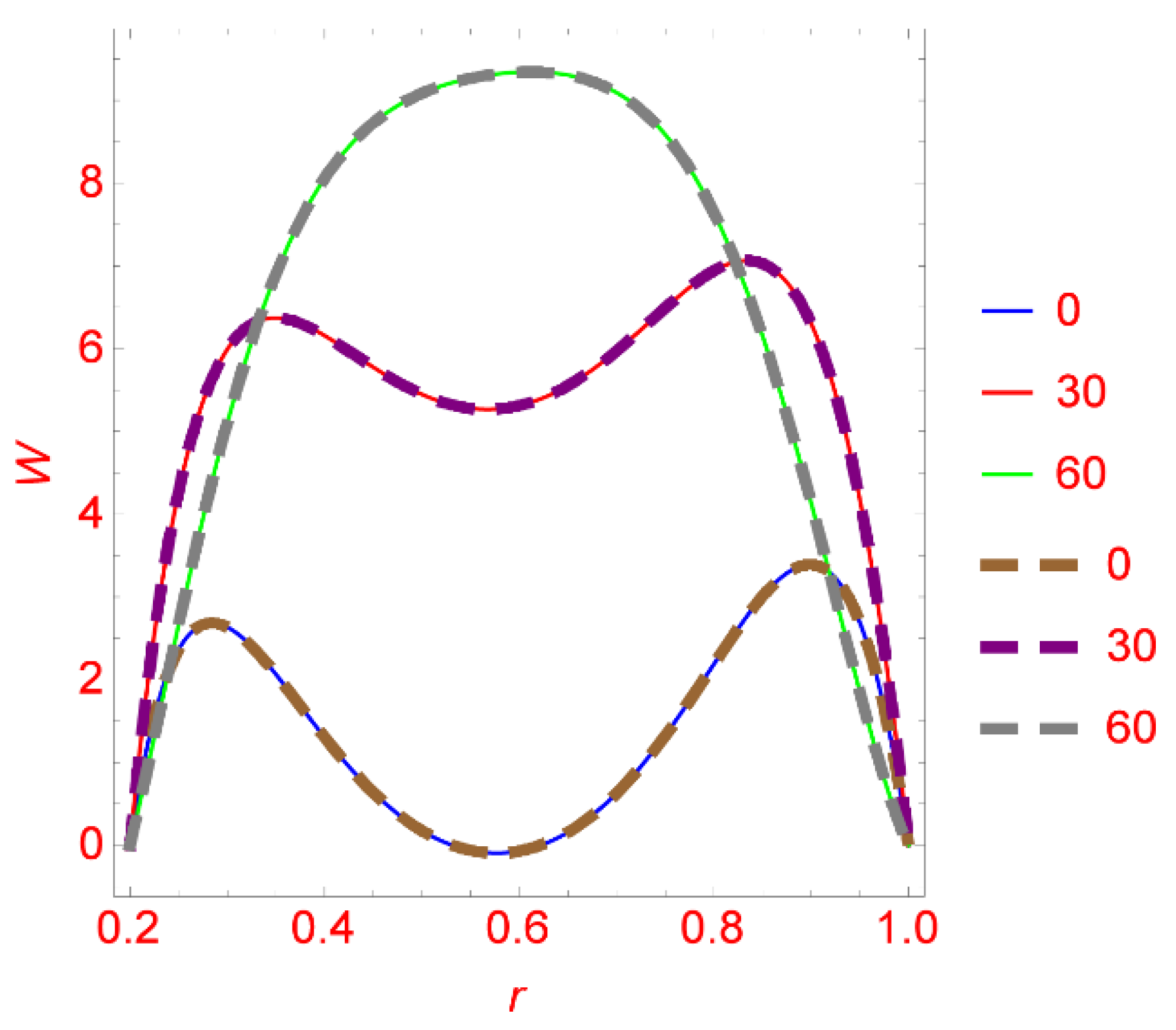
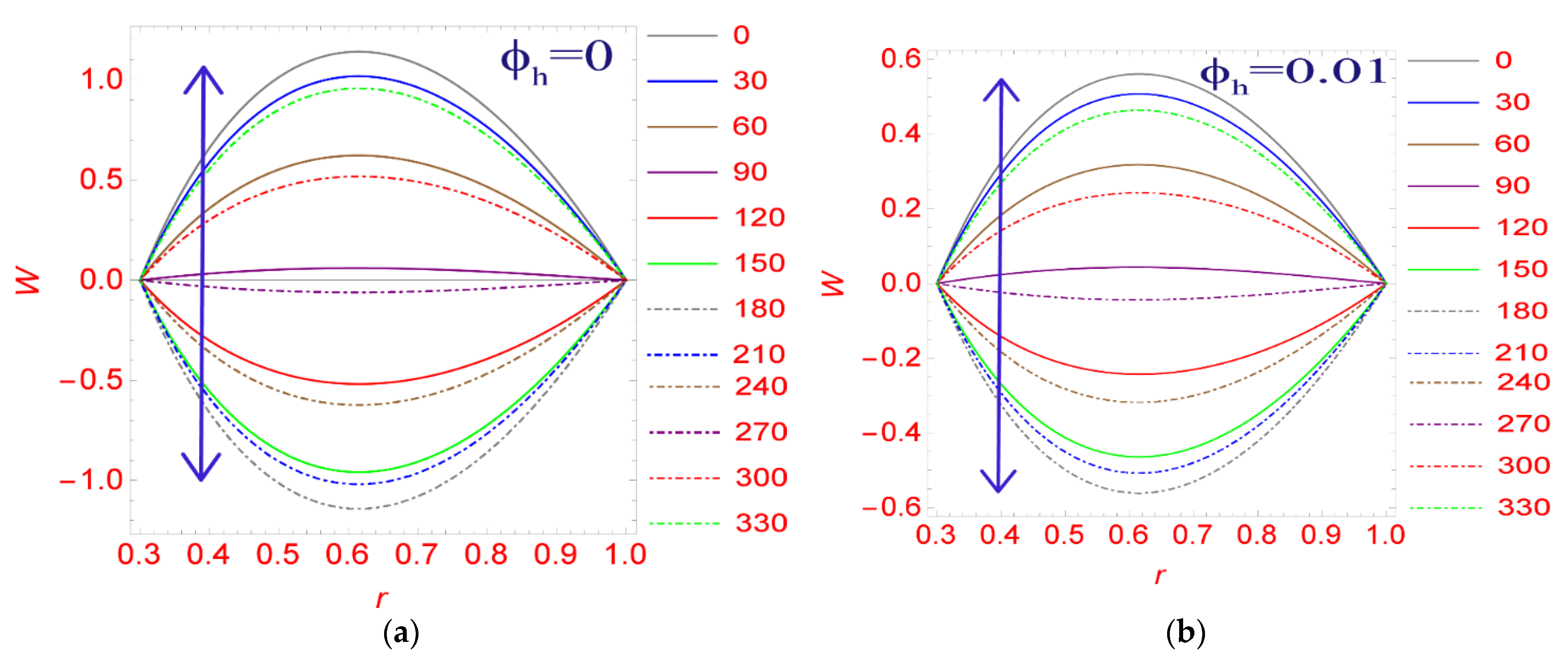
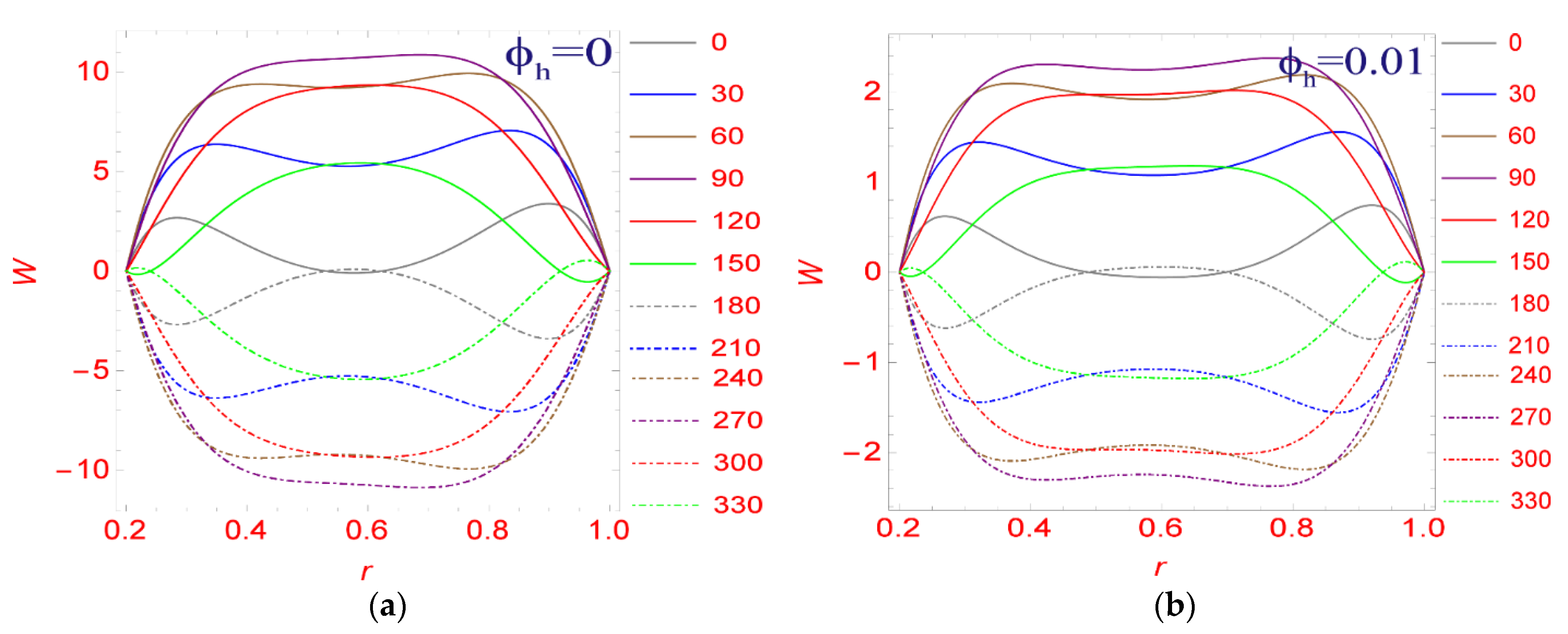
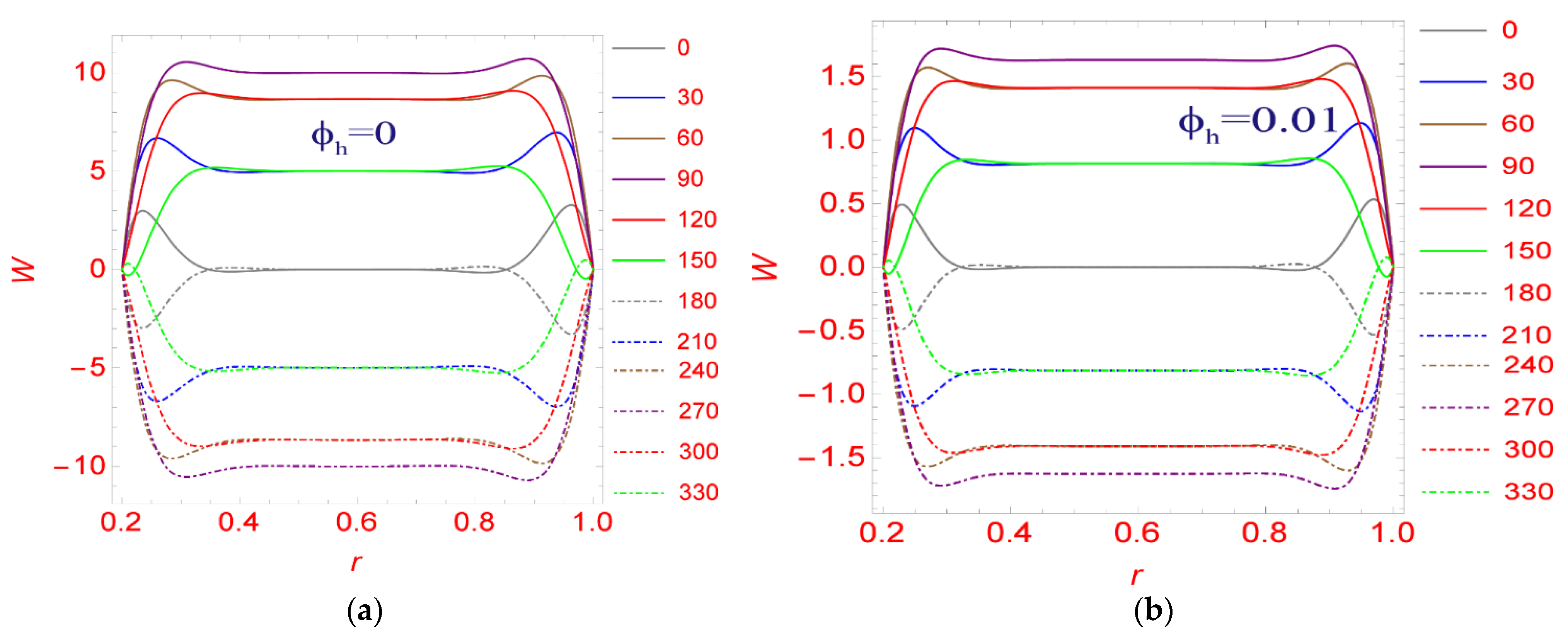
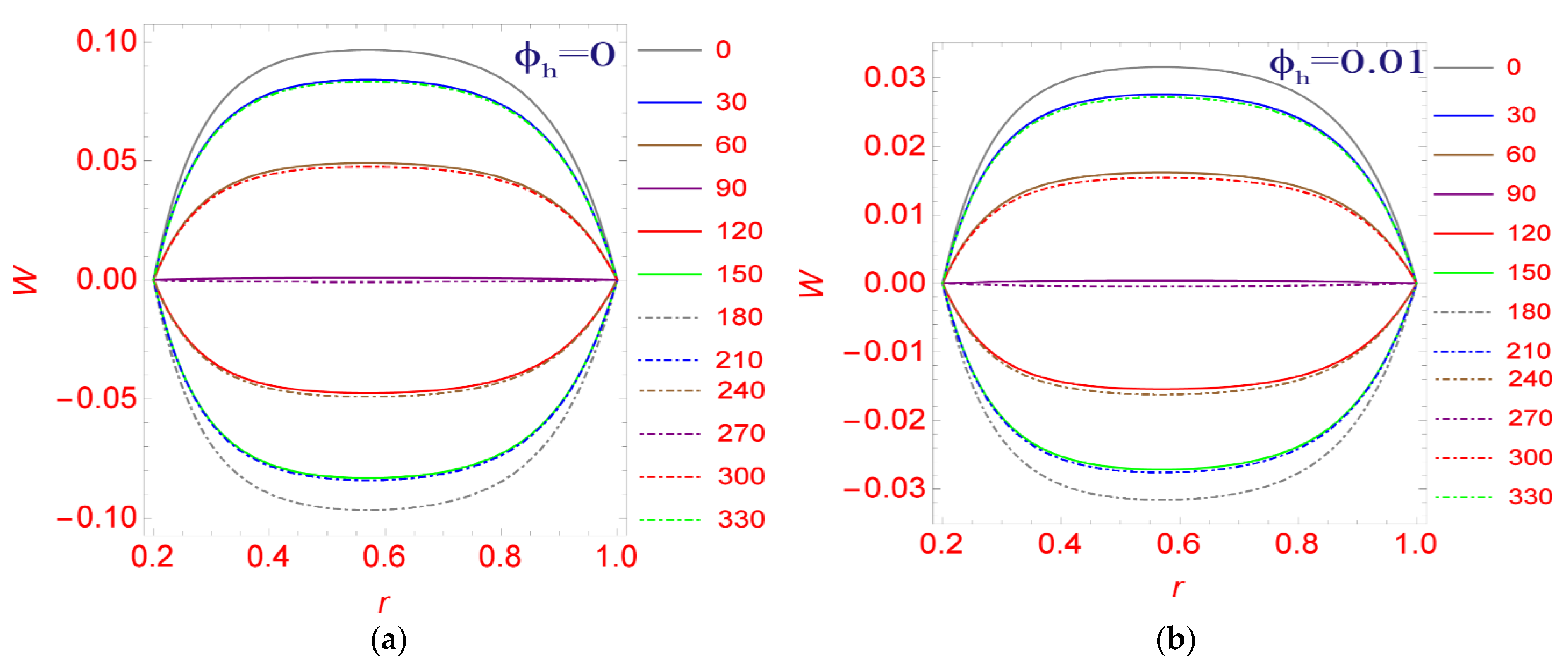
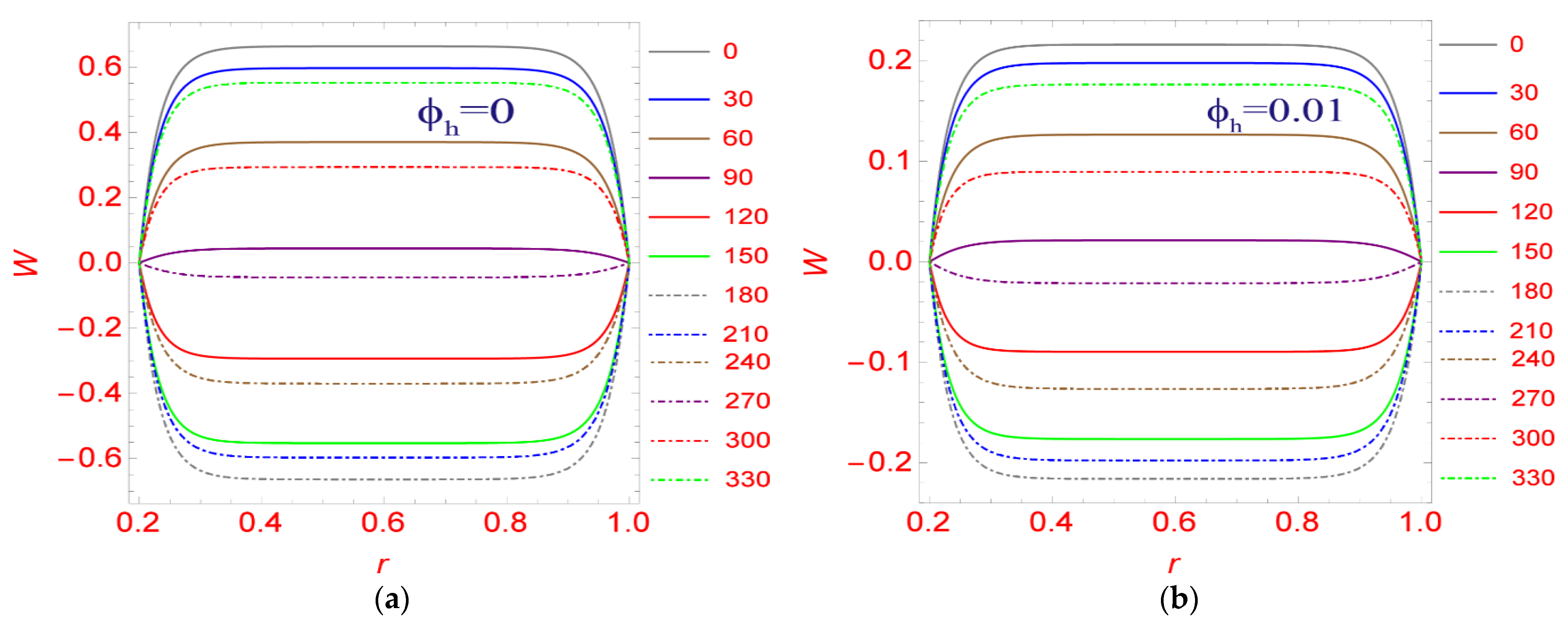
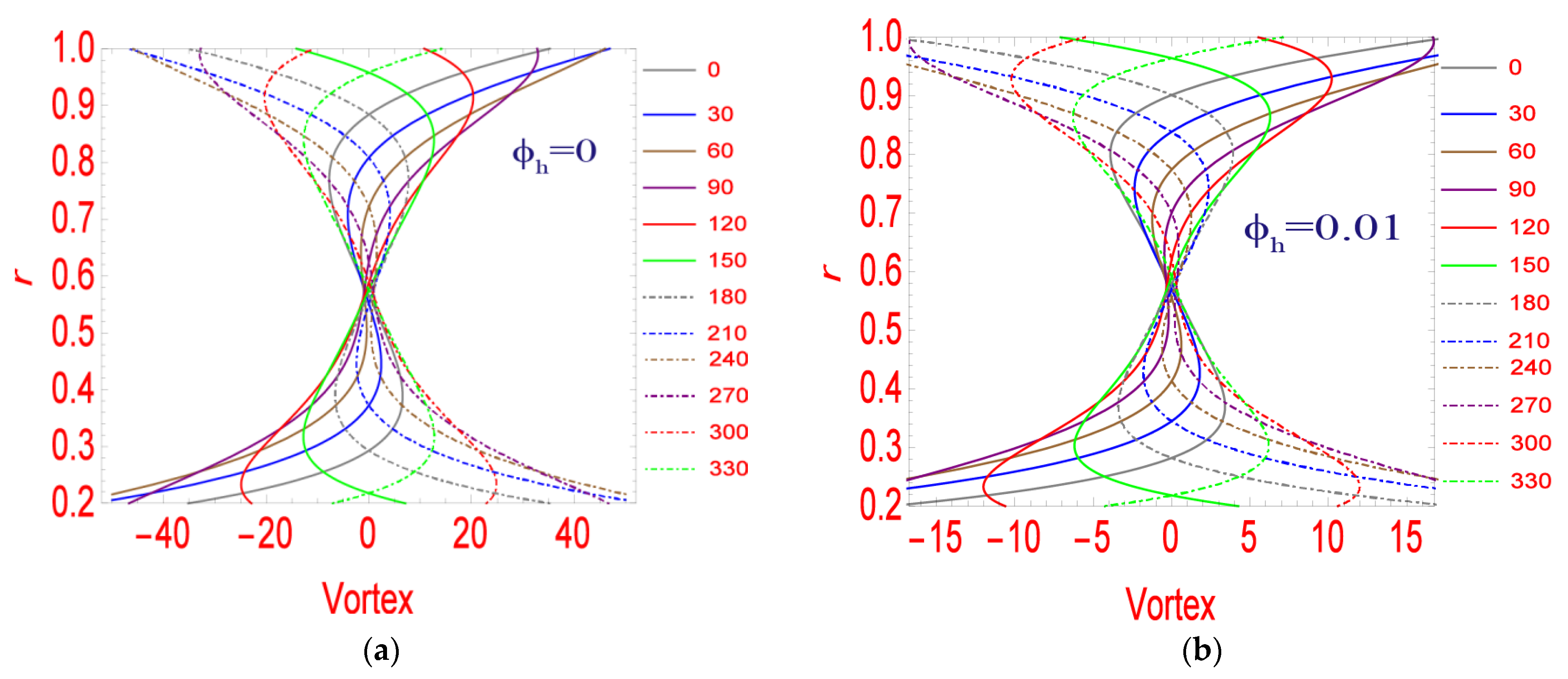
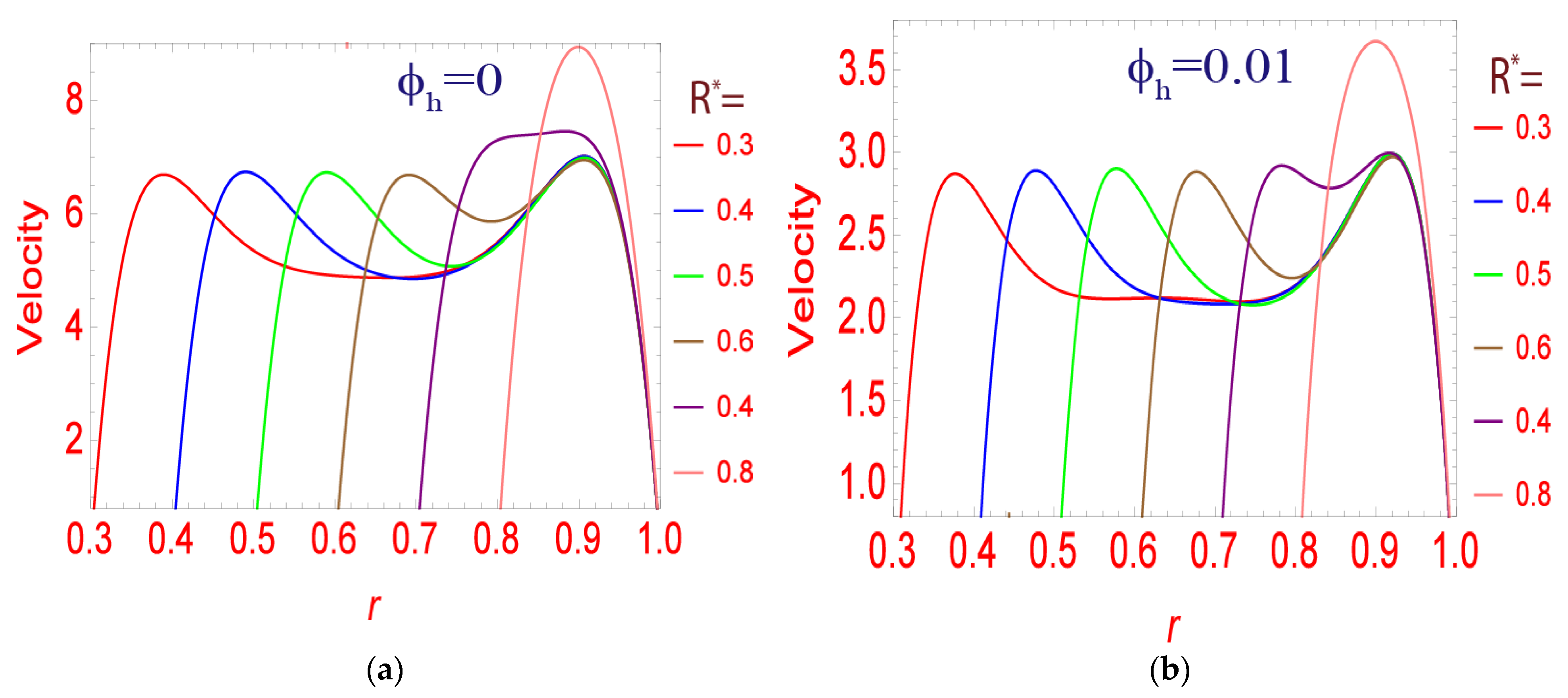

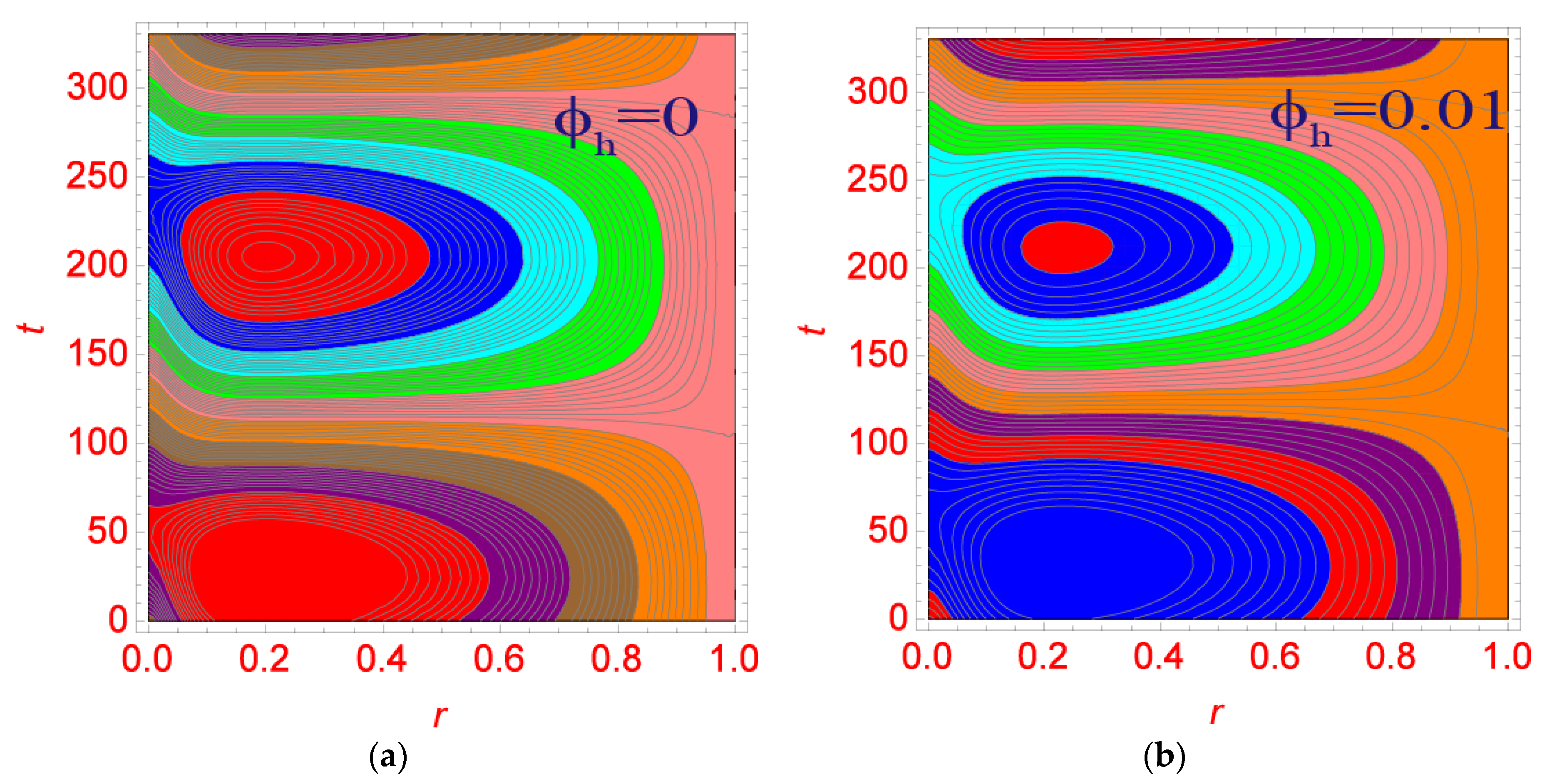
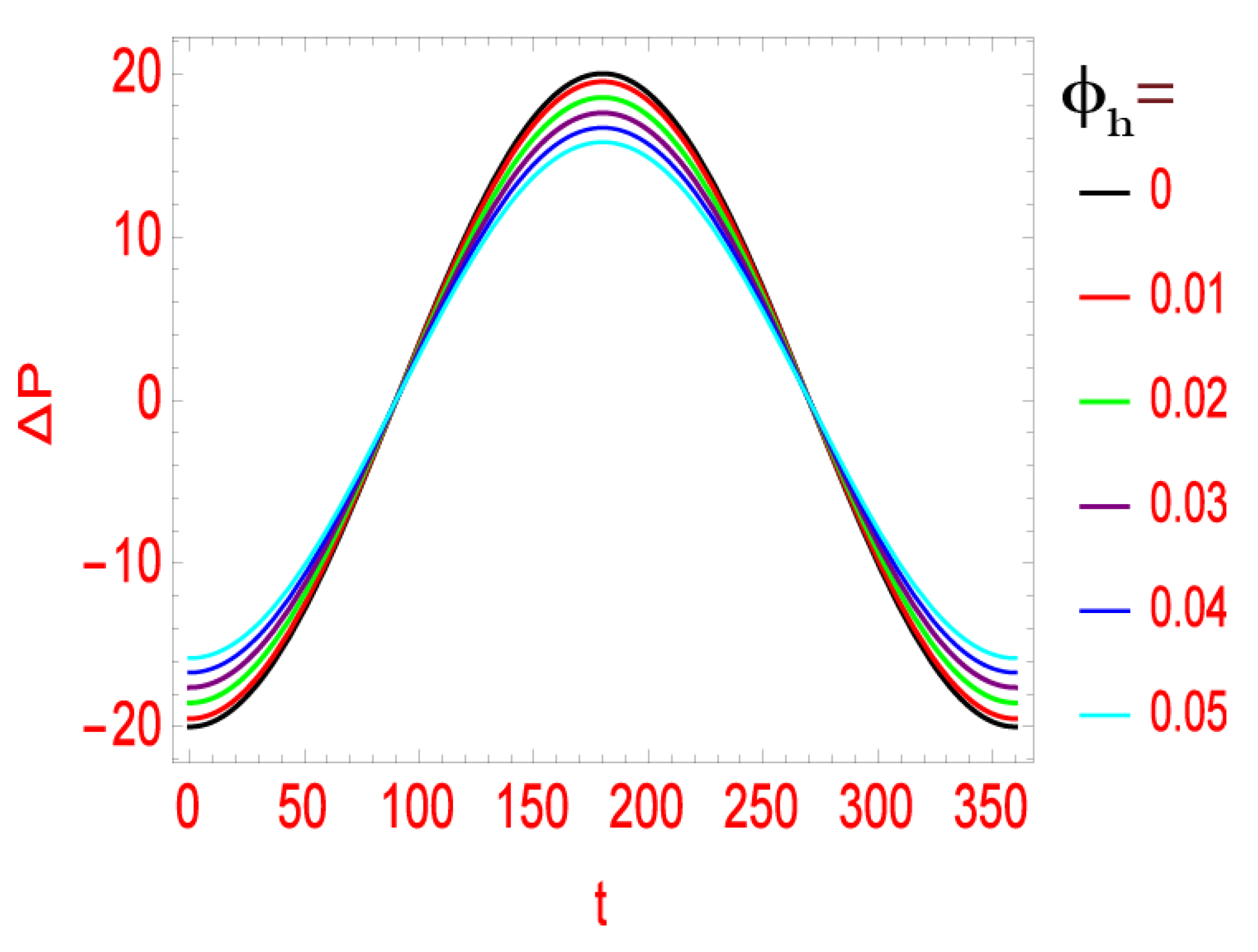
| Features | Hybrid Nanofluid |
|---|---|
| Thermophysical | |||||
|---|---|---|---|---|---|
| Blood | 1063 | 3594 | 0.667 | 0.492 | 21 |
| Silver (Ag) | 10,500 | 235 | 6.3 | 429 | - |
| Gold (Au) | 19,282 | 129 | 4.1 | 310 | - |
Publisher’s Note: MDPI stays neutral with regard to jurisdictional claims in published maps and institutional affiliations. |
© 2022 by the authors. Licensee MDPI, Basel, Switzerland. This article is an open access article distributed under the terms and conditions of the Creative Commons Attribution (CC BY) license (https://creativecommons.org/licenses/by/4.0/).
Share and Cite
Shahzad, F.; Jamshed, W.; Aslam, F.; Bashir, R.; Tag El Din, E.S.M.; Khalifa, H.A.E.-W.; Alanzi, A.M. MHD Pulsatile Flow of Blood-Based Silver and Gold Nanoparticles between Two Concentric Cylinders. Symmetry 2022, 14, 2254. https://doi.org/10.3390/sym14112254
Shahzad F, Jamshed W, Aslam F, Bashir R, Tag El Din ESM, Khalifa HAE-W, Alanzi AM. MHD Pulsatile Flow of Blood-Based Silver and Gold Nanoparticles between Two Concentric Cylinders. Symmetry. 2022; 14(11):2254. https://doi.org/10.3390/sym14112254
Chicago/Turabian StyleShahzad, Faisal, Wasim Jamshed, Farheen Aslam, Rasheeda Bashir, El Sayed M. Tag El Din, Hamiden Abd El-Wahed Khalifa, and Agaeb Mahal Alanzi. 2022. "MHD Pulsatile Flow of Blood-Based Silver and Gold Nanoparticles between Two Concentric Cylinders" Symmetry 14, no. 11: 2254. https://doi.org/10.3390/sym14112254
APA StyleShahzad, F., Jamshed, W., Aslam, F., Bashir, R., Tag El Din, E. S. M., Khalifa, H. A. E.-W., & Alanzi, A. M. (2022). MHD Pulsatile Flow of Blood-Based Silver and Gold Nanoparticles between Two Concentric Cylinders. Symmetry, 14(11), 2254. https://doi.org/10.3390/sym14112254








